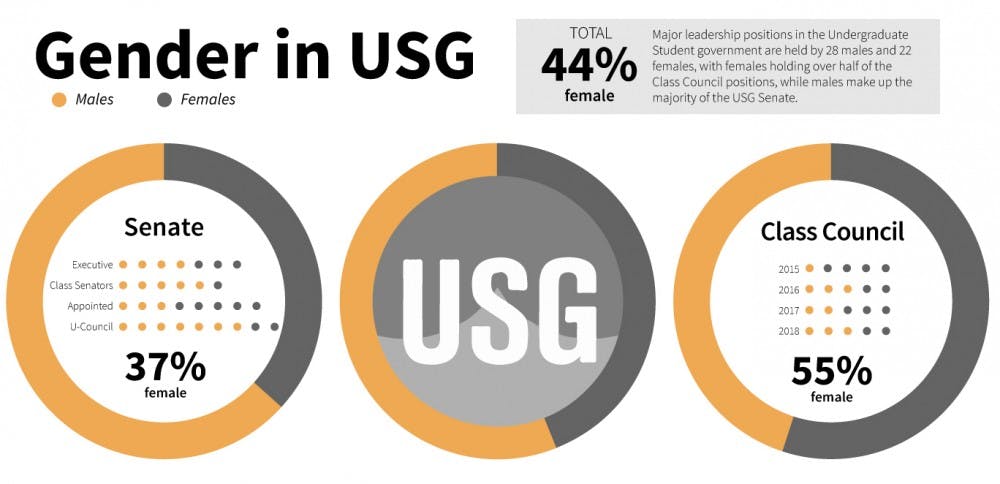“USG: where men are presidents and women are secretaries” is one of a series of posters that have spawned conversations about equal gender representation around campus, most notably in regards to the Undergraduate Student Government and campus leadership in general.
Sponsored by the Women’s Center, the aforementioned USG poster is one of many that points out certain gender practices at the University. Others depict a man who calls himself a feminist and a woman who calls herself a future CEO.
Amada Sandoval, director of the Women’s Center, declined to comment on the posters.
“We’ve talked a little about the poster that mentions USG, and we appreciate that the Women’s Center is promoting dialogue about how to get more women in these positions on USG, specifically in the role of president,” USG president Shawon Jackson ’15 said.
USG vice president Molly Stoneman ’16 said that senate positions along with U-Councilor and class representative positions have demonstrated increasingly equal gender representation. While she said that overall the USG reflects a diverse group of students in every respect, she added that the role of president has been historically dominated by men.
Nina Langsam ’03 was the last female student to serve as USG president, serving more than a decade ago, from spring 2002 to spring 2003. Jackson, who is in his second term as USG president, noted that his opponents were exclusively male each year he ran for president.
Overall, 22 individuals of the 50 current USG members are female, making USG 44 percent female.
Within the class councils, there are 11 female class officers and nine male class officers, resulting in a 55 percent female class council on average. Meanwhile, the senate has 11 women and 19 men, making the senate 36.7 percent female.
However, gender distribution varies greatly by class year and position — four of the five 2015 class council members are female, whereas only one out of the six current class senators is female.
Both Jackson and Stoneman indicated that on the whole they think the genders are equally represented in the USG senate and among U-councilors and class officers. They also agreed that students of both genders contribute to discussion equally in USG meetings.
However, the USG is looking to increase outreach to women in future elections.

“We’re thinking about specific outreach to women for upcoming elections to make sure they consider running for all of our executive positions,” Jackson said. “In addition, we’ll also be talking to members on the USG senate about how they can do individual outreach to people who are committee members, for example, but may not consider a role on the executive committee.”
Individual outreach might also consist of USG members personally reaching out to women on campus and using social media and emails to encourage female students to run for president and other USG positions, Stoneman said.
Stoneman said the USG has also worked with the Office of the Dean of Undergraduate Students, which has directed them to work with the Women’s Center and the Women’s Mentorship Program, to promote female leadership both in the USG and across campus in general.
USG coordinated with the Women’s Center for a Women in Elections event earlier this year, which Stoneman said was meant to encourage females to seek out leadership positions.
“We find in collaboration with the Women’s Center that a lot of the highest positions, including USG president but also including The Daily ‘Prince’ Editor in Chief and the Whig-Clio president and the eating club presidents tend to be very heavily male,” Stoneman said.
However, not all students thought that the posters were the best way to address the issue.
“Essentially, I think that some of them do have accurate dimensions to them, but they don’t really allow for critical conversation is the problem,” Lara Norgaard ’17 said of the posters. “For example, I do think we have a serious issue with women in leadership in eating clubs and USG. At the same time, a poster that almost blames isn’t a good way to approach that.”
In discussing the probable causes of women’s lack of representation in executive positions, Stoneman mentioned a 2011 report of the Steering Committee on Undergraduate Student Leadership. This 100-page report found that women were less likely to self-nominate; rather they choose to run for elections after being approached and encouraged by mentors or friends. It also found that while women and men tended to enter college at similar confidence levels, women had lower confidence than men by the time of graduation.
The report also mentioned the different group dynamics for men and women, saying that women are more likely to work in teams whereas men are more likely to express their leadership in what Stoneman referred to as a “singular way” when summarizing the study.
The report also conveyed that women were more hesitant to speak their minds immediately in conversation and took more time to compose their thoughts beforehand.
Stoneman added that it may be easier for women to fall through the cracks in elections because men may be viewed as stronger presences because their voices are naturally deeper and louder, making it easier for men to command attention.
Stoneman said she hadn’t considered running for president herself last year because she was only a sophomore but would potentially consider it in the future.
“As far as running for vice president, I thought I would do a good job with it,” Stoneman said. “I also saw myself as a compatible leader alongside Shawon.”
Despite both Jackson’s and Stoneman’s endorsement of the conversation the Women’s Center is starting with these posters, Stoneman disagreed with the poster’s portrayal of the secretary position, a position she held last year.
“We find the statement to be rather misleading because actually in the USG senate the position of secretary is amongst the most high ranking and visible positions in the organization,” Stoneman said.








